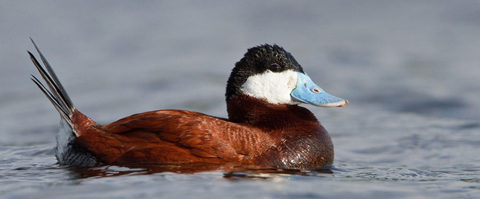
11 Jan 2017 THE EU INVASIVE ALIEN SPECIES LIST: CONSEQUENCES AND GUIDANCE FOR HUNTERS
The European Union (EU) Regulation on Invasive Alien Species (IAS), which established the first EU list of IAS, came into force in July 2016. The list currently comprises 37 species (23 animals and 14 plants) considered to have potential adverse impacts across the EU.
CONSEQUENCES OF THE LIST
This Regulation sets out the restrictions and measures that will now apply to the species on the Union list on keeping, importing, selling, breeding and growing.
Among the 23 animal species on the list, four are of interest to hunters. These are the Grey Squirrel (Sciurus carolinensis), the Raccoon (Procyon lotor), the Ruddy Duck (Oxyura jamaicensis) and the Muntjac Deer (Muntiacus reevesii). Egyptian Goose (Alopochen egyptiacus), Raccoon Dog (Nyctereutes procyonoides) and Muskrat (Ondatra zibethicus) could potentially be added.
Specifically, EU Member States are now required to take measures for early detection and rapid eradication of these species, and to manage species that are already widely spread in the territory of some Member States.
National hunting associations should discuss with their respective Government Ministries how they can be better supported in their efforts to monitor and control IAS. Important resources could include traps and trial cameras.
GUIDANCE FOR HUNTERS ON IAS SURVEILLANCE AND MANAGEMENT ACTIVITIES
The control of Invasive Alien Species represents a big challenge in which hunters play a significant role. FACE advises hunters and national hunting associations to continue to support the following principles:
MONITORING/SURVEILLANCE
Hunters should continue to participate in monitoring schemes (e.g. using trial cameras) to obtain information on the IAS present in their area and their associated impacts. This kind of activity should aim to record species not previously observed, which is of crucial importance for early detection of IAS and to respond rapidly.
AWARENESS
Hunters should continue to keep well-informed via hunting magazines and other media of IAS trends, distribution and the most effective eradication/control methods. This is an effective means to inform hunters to take appropriate actions.
Hunters and national hunting associations should continue to raise awareness about IAS via education programmes, projects open-days, social media, public events and other campaigns.
ERADICATION
Hunters should continue to help with the eradication of IAS. In many countries, IAS can be controlled year round under certain conditions or during a specified open season.
Hunters should keep up to date with the most effective eradication methods.
MANAGEMENT
Hunters should continue to control the spread, abundance and density of IAS in order to prevent them from spreading into non-occupied areas.
For more information about hunters actions on IAS, see → WHAT ARE HUNTERS DOING TO COMBAT IAS?

